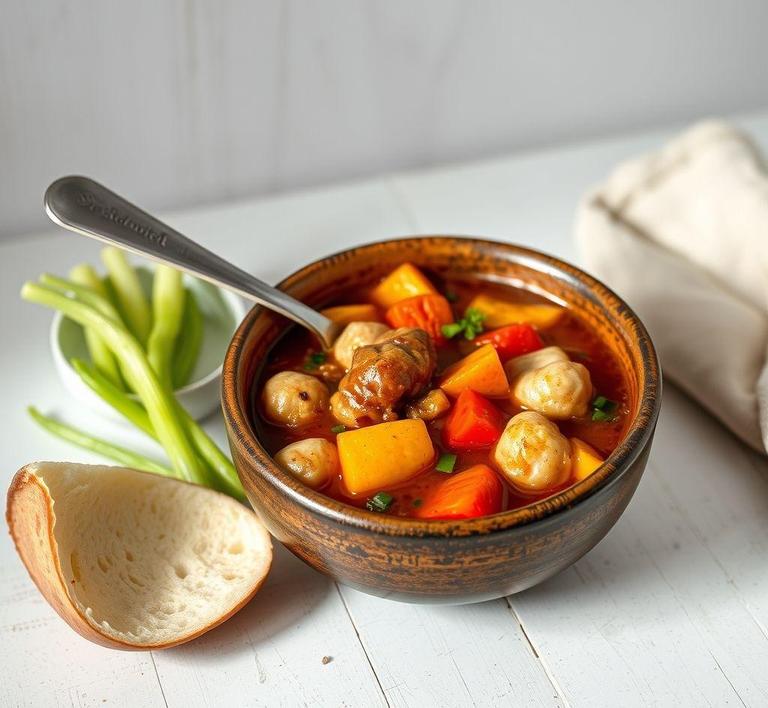Brunswick stew is a hearty, comforting dish that’s perfect for feeding a crowd or meal prepping for the week ahead. But what happens when you’ve made too much and don’t want to waste any of that deliciousness? Refreezing Brunswick stew can be a great way to preserve leftovers, but it’s important to do it properly to maintain the flavors and texture. This guide will walk you through the best methods for refreezing Brunswick stew, covering tips on how to store it, how long it stays good in the freezer, and any potential changes to expect after thawing and reheating. With these steps, you can enjoy your stew just as much the second time around!
Can You Refreeze Brunswick Stew?

Yes, you can refreeze Brunswick stew-but with a few important caveats.
Refreezing any food, including a complex dish like Brunswick stew, hinges on one key factor: whether the stew was thawed safely. If you defrosted the stew in the refrigerator and it was kept at a consistent, safe temperature (below 40°F/4°C), then it’s safe to refreeze. However, if the stew was left out on the counter at room temperature for more than two hours-or thawed in warm water or the microwave-refreezing becomes risky due to the potential growth of harmful bacteria.
Because Brunswick stew is typically made with a combination of chicken, pork, beef, tomatoes, lima beans, corn, and sometimes potatoes, it’s especially sensitive to improper temperature handling. Meat and dairy-based ingredients are particularly vulnerable to bacterial contamination when repeatedly moved between hot and cold environments.
In short: Yes, refreezing is possible-but only if the stew was thawed safely and hasn’t sat at room temperature for long.
How To Refreeze Brunswick Stew?
If you’ve determined that your Brunswick stew meets the safety criteria for refreezing, here’s a step-by-step guide to doing it properly while preserving as much quality as possible:
-
Cool It Down Quickly:
Before refreezing, allow the stew to cool completely in the refrigerator. Never put hot or even warm stew directly into the freezer, as this can cause condensation and ice crystals to form, which degrade both texture and flavor.
-
Portion Wisely:
Divide the stew into meal-sized portions using airtight containers or heavy-duty freezer bags. This not only makes it easier to thaw later but also helps avoid repeated thaw-and-freeze cycles.
-
Remove Excess Air:
If using freezer bags, press out as much air as possible to reduce the risk of freezer burn. For containers, consider placing a layer of plastic wrap over the surface of the stew before sealing.
-
Label and Date:
Mark the container with the refreezing date. Generally, Brunswick stew should be consumed within 2 to 3 months for optimal flavor and texture.
-
Freeze Promptly:
Place the stew into the coldest part of the freezer to ensure it freezes quickly. Rapid freezing helps minimize the formation of large ice crystals, which can damage the cell structure of the ingredients.
Quality Impact
While it is safe to refreeze Brunswick stew if handled properly, the real question is-should you?
Here’s where quality comes into play.
When you freeze and thaw a dish like Brunswick stew, the water in the vegetables and meats expands and contracts. This process can rupture cell walls, leading to a change in texture. Once refrozen, these textural issues often become more pronounced:
- Vegetables like corn, lima beans, and tomatoes may become mushy.
- Meats (especially shredded chicken or pork) may turn dry or grainy.
- Sauces and broths may separate slightly, requiring re-emulsification through reheating and stirring.
That said, the rich, stew-like consistency of Brunswick stew is generally more forgiving than other dishes. If it’s a bit thicker or has a slightly different texture after refreezing, a good stir and gentle reheat on the stovetop can often restore its soul-warming goodness.
For best results, avoid refreezing more than once. Each cycle of freezing and thawing diminishes the integrity of the ingredients further.
Refreezing Brunswick stew is certainly possible-and often practical-especially when trying to minimize food waste. The key lies in ensuring safe thawing practices and carefully managing your leftovers. While some quality loss is inevitable due to the nature of freezing and thawing, Brunswick stew is hearty and resilient enough to withstand a second freeze with minimal compromise, especially if you follow best practices for storage and reheating.
In the end, the decision to refreeze comes down to balancing convenience, safety, and flavor. If your stew has been handled properly, go ahead and freeze it again with confidence-just know that your next bowl may not be quite as vibrant as the first, but it will still be comforting, rich, and satisfying.
Is It Safe To Refreeze Brunswick Stew?
Brunswick stew-a hearty, Southern classic traditionally brimming with tomatoes, lima beans, corn, and a mix of meats like chicken, pork, or even game-makes for a soul-warming, flavor-rich dish. But as delightful as it is when fresh, there’s often plenty left over, especially when prepared in large batches. That leads to the inevitable question: Can you refreeze Brunswick stew?
The short answer is: yes, you can-but with important caveats.
Refreezing Brunswick stew is safe if the stew has been thawed properly (in the refrigerator, not on the countertop), has not been kept at room temperature for more than 2 hours, and has not shown any signs of spoilage. When thawed in the fridge, the stew remains below the bacterial ‘danger zone’ (40°F-140°F), which greatly reduces the risk of foodborne illness. If it has been handled correctly, refreezing won’t inherently cause harm.
However, while it’s microbiologically safe under these conditions, there is a trade-off when it comes to texture and taste. Repeated freezing and thawing can break down the stew’s components. Vegetables become mushier, and the integrity of the meat may deteriorate. The flavors might dull slightly, and the stew could lose its signature rich, comforting consistency. So while it’s not dangerous, refreezing should ideally be done sparingly and only when necessary.
Signs That Brunswick Stew Should Not Be Refrozen
Knowing when to skip the refreeze is crucial to both safety and quality. Here are the key indicators that Brunswick stew has reached the point of no return:
-
Off Odors
If your stew emits an unpleasant sour, rancid, or ammonia-like smell, do not refreeze it-or even taste it. Spoiled meat and vegetables often produce these tell-tale signs of bacterial growth.
-
Change in Texture or Appearance
If the stew appears overly slimy, has an oily separation, or displays mold spots (even tiny ones), it has likely started to spoil. The vibrant reddish-brown hue of a fresh Brunswick stew will dull considerably when it’s gone bad.
-
Improper Thawing
Stew that has been left out at room temperature for over two hours-or thawed using warm water or a microwave but then not eaten immediately-should never be refrozen. The bacterial activity in those conditions skyrockets.
-
Repeated Temperature Fluctuations
If the stew has been in and out of the fridge or left sitting in a lukewarm slow cooker for hours, its safety is compromised. Even if it doesn’t yet smell spoiled, bacteria can multiply without changing flavor or aroma early on.
Common Refreezing Mistakes
Mistakes in the refreezing process can turn your hearty comfort meal into a health hazard or an unappetizing mush. Here’s what to avoid:
-
Refreezing After Improper Thawing
As mentioned, thawing at room temperature is a major misstep. Many assume they can simply refreeze it after a few hours on the counter, but that time allows dangerous bacteria to multiply rapidly.
-
Refreezing Large Quantities at Once
A big container of stew takes longer to freeze and thaw evenly. This prolonged exposure increases the risk of bacterial growth in the center. Always portion your stew before freezing or refreezing.
-
Not Labeling or Dating
Many people forget to label and date containers. This leads to mystery stews in the back of the freezer and the temptation to refreeze without knowing how old they are. Keep a clear record to avoid guesswork.
-
Using Inadequate Containers
Freezer burn is real-and ruinous. Reusing old containers that aren’t airtight can expose your stew to freezer burn, which saps moisture and flavor. Vacuum-sealed bags or quality freezer-safe containers are best.
Tips And Tricks
Want to refreeze Brunswick stew the right way without sacrificing taste or safety? These tips will make all the difference:
-
Freeze in Individual Portions
Dividing stew into single-serving containers before freezing not only speeds up thawing and refreezing but also helps you use only what you need, reducing food waste.
-
Use Heavy-Duty Freezer Bags
Lay them flat to freeze, then stack them to save space. This also helps the stew thaw faster and more evenly when reheated.
-
Chill Before Freezing
Allow the stew to cool completely in the fridge before placing it in the freezer. Putting hot food directly into the freezer can lower the overall freezer temperature and compromise other items.
-
Label Everything
Include the date and any thawing instructions. Stick to the general rule: food should only be refrozen once for best results. Keep a ‘first in, first out’ rotation method for your frozen meals.
-
Reheat Thoroughly
When ready to eat the refrozen stew, reheat it until it reaches an internal temperature of 165°F (74°C). Stir well to ensure even heating, especially if microwaving.
Conclusion
Brunswick stew, with its tender meats and savory, slow-simmered vegetables, is a dish worth savoring down to the last spoonful. While refreezing this comforting classic is certainly possible and safe under the right conditions, doing so requires careful attention to thawing practices, storage methods, and telltale signs of spoilage. By avoiding common mistakes and following a few smart tips, you can preserve both the flavor and safety of your leftover stew-ensuring that every bowl, whether fresh or refrozen, is as satisfying as the first.
In the end, the key to mastering the art of refreezing Brunswick stew lies in preparation and mindfulness. A little care goes a long way in keeping comfort food both safe and scrumptious.


